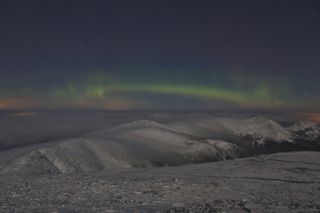
Northern Lights Dance Over New England (Photos)

The northern lights spilled over into New England last night, courtesy of an eruption on the sun that supercharged a geomagnetic storm.
From the top of the Northeast's highest peak, a night observer at New Hampshire's Mount Washington Observatory snapped pictures of the greenish glow of auroras around 1:00 a.m. EST, and then again just after 2:00 a.m. EST. At 6,288 feet (1,916 meters) tall, Mount Washington is famous for its erratic weather and whipping winds, but skies were clear over the observatory overnight.
The shimmering lights were also visible across the state border, in Maine, where photographer John Stetson stood on the frozen edge of Sebago Lake early Wednesday and pointed his camera north towards Raymond Beach. [See Photos of Amazing Auroras]

"A green ribbon of color could be seen on the horizon, and a purple-blue could be seen extending skyward," Stetson wrote in an email. He pointed out that the 1,619-foot-tall (493 meters) communications tower that cuts through the auroras was the tallest man-made structure in the world when it was built in 1959.
The northern lights, or aurora borealis, flare up when high-speed charged particles from solar storms slam into Earth's magnetic field, sparking geomagnetic storms. Ions of oxygen and nitrogen in the upper atmosphere can get excited during these storms, producing electrifying bands of color in the night sky. (The phenomenon also occurs in the Southern Hemisphere, over Antarctic skies, and is known as the aurora australis, or southern lights.)
According to forecasters at Spaceweather.com, a minor geomagnetic storm was already underway when a coronal mass ejection, or CME, sent a huge cloud of solar material speeding toward Earth. The CME impacted the planet around 9:00 p.m. EST Tuesday (0200 UTC Wednesday) and further fueled the geomagnetic storm, triggering auroras in the northerly parts of the continental United States.
Nighttime photographers were able to capture the northern lights in the Midwest, the Great Lakes region and in the Pacific Northwest, too. Pictures of auroras shared on Spaceweather.com were submitted from locales like Sauk Rapids, Minn., Bellevue, Wash., and Crofton, Neb.
Sign up for the Live Science daily newsletter now
Get the world’s most fascinating discoveries delivered straight to your inbox.
Follow Megan Gannon on Twitter and Google+. Follow us @livescience, Facebook & Google+. Original article on Live Science

Most Popular


